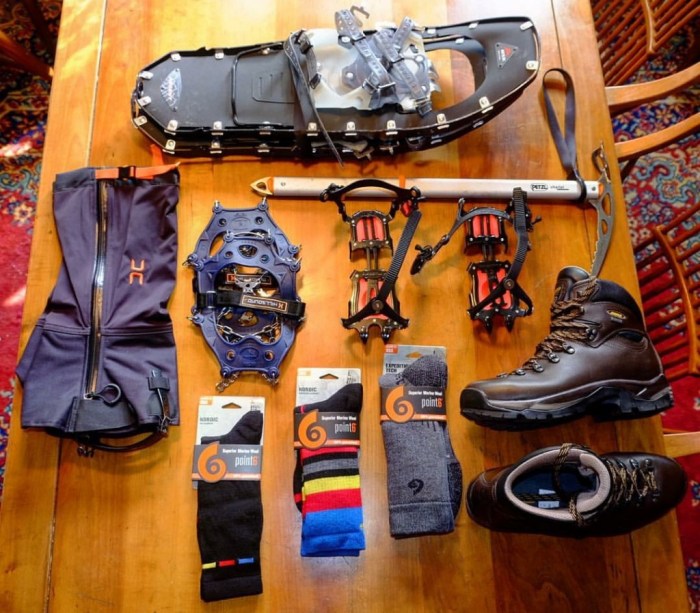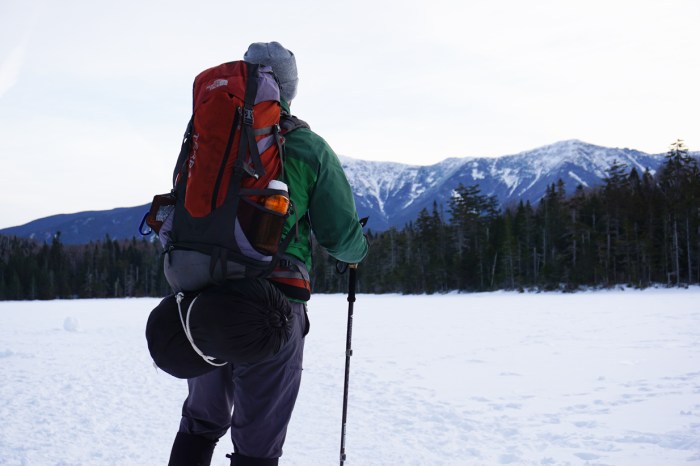Winter Hiking Gear: Conquering winter trails requires meticulous preparation. This isn’t just about bundling up; it’s about strategic layering, reliable equipment, and a deep understanding of potential hazards. From mastering the three-layer clothing system to selecting the perfect boots and backpack, we’ll equip you with the knowledge to navigate snowy landscapes with confidence and safety. This guide will transform your winter hiking experience, turning potential challenges into thrilling adventures.
We’ll cover everything from choosing the right fabrics and understanding their properties to packing your backpack efficiently and knowing how to handle unexpected weather changes. We’ll also explore essential safety gear, navigation techniques, and crucial first-aid knowledge. By the end, you’ll be prepared to tackle any winter trail with the right gear and the right mindset.
Footwear and Socks: Winter Hiking Gear

Conquering winter’s icy trails requires more than just determination; it demands the right gear. Your footwear and socks are the foundation of your comfort and safety, directly impacting your ability to enjoy the hike and avoid injury. Investing in high-quality, appropriately chosen footwear and socks is crucial for a successful and enjoyable winter hiking experience.Choosing the right footwear and socks is paramount for a successful winter hike.
Improper gear can lead to blisters, frostbite, and even serious injuries. Let’s delve into the specifics.
Waterproof and Insulated Hiking Boots
Waterproof and insulated hiking boots are essential for winter hiking. The waterproof membrane prevents snow and water from penetrating the boot, keeping your feet dry and warm. Insulation, typically provided by materials like Thinsulate or PrimaLoft, traps warm air close to your feet, preventing heat loss and maintaining comfortable temperatures even in sub-freezing conditions. Without these features, your feet are vulnerable to hypothermia and frostbite, significantly impacting your hiking experience and potentially posing serious health risks.
Consider the level of insulation needed based on the expected temperatures; higher insulation is needed for extreme cold.
Boot Size and Fit for Winter Hiking
Selecting the correct boot size is critical. Winter hiking boots should fit snugly but not tightly. Your toes should have a little room to wiggle, preventing discomfort and potential rubbing. It’s recommended to try boots on at the end of the day, when your feet are slightly swollen, to ensure a comfortable fit throughout your hike. Consider wearing the socks you plan to use during your hike when trying on boots.
Remember that wearing thicker socks will reduce the available space inside the boot, so account for that during the fitting process. Proper fit prevents blisters and ensures optimal comfort and performance. Think of it as finding the perfect glove – it should be snug but not constricting.
Benefits of Wool or Synthetic Hiking Socks, Winter Hiking Gear
Wool and synthetic hiking socks offer superior moisture-wicking properties compared to cotton socks. Moisture wicking is crucial in winter, as wet socks can quickly lead to cold feet and potentially frostbite. Wool socks are naturally warm and breathable, even when wet. Synthetic socks, often made from materials like polyester or polypropylene, offer excellent moisture-wicking capabilities and are generally quick-drying.
Both wool and synthetic socks are superior choices for winter hiking compared to cotton, which retains moisture and can lead to discomfort and cold feet. Consider the climate and your personal preference when choosing between wool and synthetic materials.
Factors to Consider When Choosing Winter Hiking Boots
Before purchasing winter hiking boots, consider several key factors:
- Insulation Level: Choose a boot with sufficient insulation for the expected temperatures. Higher insulation ratings are needed for colder climates.
- Waterproofness: A waterproof membrane is essential to keep your feet dry in snowy and wet conditions. Look for boots with proven waterproof membranes like Gore-Tex.
- Ankle Support: Good ankle support is crucial for stability and preventing injuries on uneven terrain. Higher-cut boots offer better ankle support.
- Traction: Aggressive tread patterns are vital for secure footing on ice and snow. Look for boots with deep lugs and durable rubber outsoles.
- Weight: While heavier boots offer more support and protection, lighter boots reduce fatigue on longer hikes. Consider the balance between weight and support based on your hiking style and the length of your planned treks.
- Fit: Proper fit is paramount. Try boots on with the socks you plan to wear and ensure enough room for your toes to wiggle.
Backpack and Gear Organization

Winter hiking demands meticulous preparation, and a well-organized backpack is the cornerstone of a successful and safe adventure. Choosing the right pack and strategically packing your gear can significantly impact your comfort, efficiency, and overall experience on the trail. Ignoring these factors can lead to discomfort, unnecessary weight, and potentially dangerous situations.Proper gear organization isn’t just about fitting everything in; it’s about accessibility, weight distribution, and ensuring you have what you need when you need it.
A poorly organized pack can transform a pleasant hike into a grueling ordeal.
Backpack Selection for Winter Hiking
Selecting the right backpack is crucial for a comfortable and safe winter hiking experience. The ideal backpack size for winter hiking typically ranges from 50 to 75 liters, depending on the trip length and the amount of gear required. Larger packs offer more space for extra layers, emergency supplies, and potentially heavier equipment like snowshoes. Look for features like a durable, waterproof exterior, multiple compartments for organization, a comfortable and adjustable hip belt for weight distribution, and a well-ventilated back panel to prevent overheating.
Consider packs with attachment points for ice axes and trekking poles, which are essential for winter ascents and descents. A pack with a built-in rain cover is also highly recommended, as unexpected weather changes are common in winter conditions.
Essential Items for a Winter Hiking Backpack
A well-stocked backpack is paramount for winter hiking safety and enjoyment. Failing to adequately prepare can lead to serious consequences in challenging winter conditions. Your packing list should always prioritize safety and essential needs. Items that should never be left behind include navigation tools, first-aid supplies, extra food and water, and appropriate clothing.
Sample Winter Hiking Packing List
This sample packing list provides a framework. Adjust quantities and items based on your specific trip length, location, and personal needs. Remember, weight is a significant factor; carefully consider each item’s necessity.
| Category | Items |
|---|---|
| Clothing | Base layers (synthetic or merino wool), insulating mid-layers (fleece or down), waterproof and windproof outer shell, extra socks (wool or synthetic), warm hat, gloves or mittens, neck gaiter |
| Navigation | Map, compass, GPS device (with extra batteries), altimeter, whistle |
| Sun Protection | Sunscreen, sunglasses, lip balm with SPF |
| First-aid Supplies | Comprehensive first-aid kit (including blister treatment, pain relievers, antiseptic wipes, bandages), personal medications |
| Illumination | Headlamp or flashlight (with extra batteries) |
| Nutrition | High-energy snacks (trail mix, energy bars), extra food (consider freeze-dried meals for longer trips), water bottles or hydration reservoir |
| Tools and Repair Kit | Knife or multi-tool, duct tape, repair kit for gear |
| Emergency Shelter | Emergency bivy sack or lightweight emergency blanket |
| Fire Starter | Waterproof matches or lighter |
Weight Distribution and Packing Techniques
Efficient weight distribution is critical for comfort and preventing injuries. Heavier items should be packed close to your back and centered around your waistline. This minimizes strain on your shoulders and back, allowing for a more balanced and comfortable carry. Place lighter items in the outer pockets for easy access. Organize your pack logically, placing frequently used items in easily accessible locations.
Consider using packing cubes or dry bags to compress clothing and keep items organized. Remember to leave some extra space in your backpack to account for unexpected items or purchases during your hike. Proper packing techniques significantly reduce fatigue and improve overall hiking experience. Consider using compression sacks to minimize the overall size of your gear, making it easier to fit everything in your backpack while maintaining a streamlined profile.
Successfully navigating winter hikes hinges on meticulous planning and the right gear. This guide has provided a comprehensive overview, from the importance of layering clothing to the selection of crucial safety equipment. Remember, preparation is key. By understanding the principles of layering, choosing appropriate footwear and a well-fitted backpack, and mastering basic navigation and safety protocols, you’ll not only enhance your comfort but significantly reduce risks.
Embrace the challenge, prepare thoroughly, and enjoy the unparalleled beauty of winter hiking.

